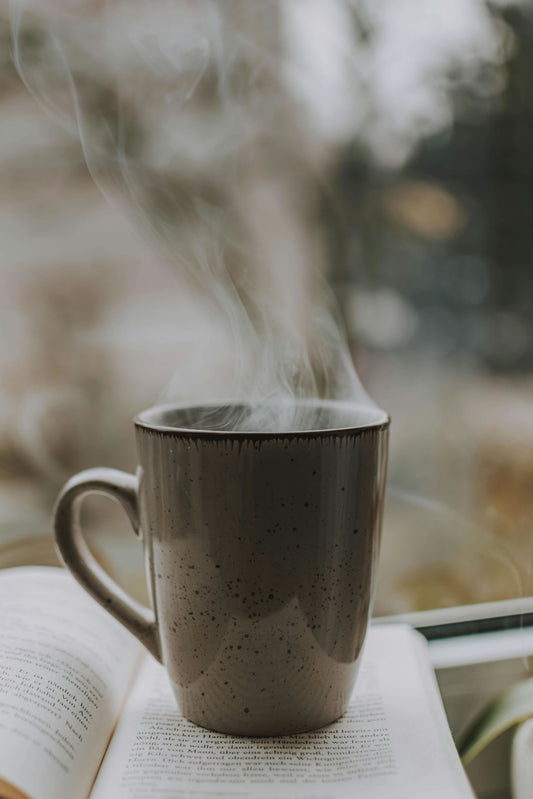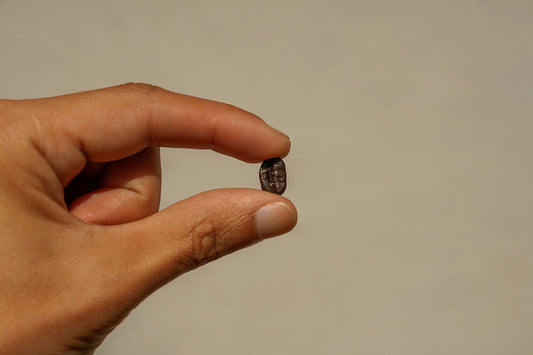It can be confusing to decipher the subtle distinctions between the various coffee offerings, whether we're ordering for breakfast, lunch, or dinner. Those who prefer their coffees with more milk often choose between the latte and the flat white. What sets a flat white apart from a latte, though? Does it even exist? Keep reading to learn everything there is to know about the distinctions between the two.
Origins Of Flat White
It wasn't until the 1980s that the flat white became a popular beverage. However, the people of New Zealand and Australia continue to argue over the origin to this day. Derek Townsend, a New Zealand barista, is credited with creating the drink in 1980. New Zealand urban legend has it that he was so familiar with the recipe that he could whip up an unbelievable 1,500 flat whites in an hour. Making 60 drinks in an hour is challenging for baristas, let alone making 1500.
Australians believe that Fraser McInnis came up with the term "flat white" to describe a Cappuccino that lacked the proper amount of foam. Let's forget about finding out which version is accurate and move on.
The flat white you order may be brewed differently than you're used to depending on the coffee shop. In comparison to a latte or cappuccino, the consistency is noticeably thinner. This is because, unlike steamed milk or regular whole milk, microfoam is used in its preparation. Carefully crafted microfoam with a silky texture is poured into one or two espresso shots (depending on what you want). Not only will you feel the caffeine rush, but the drink will also be smooth and creamy without any froth.
Origin of Latte
It first appeared in the 1950s. Since then, many Europeans have diluted their coffee with milk because the original brew was too powerful. The latte evolved after some Americans complained that cappuccinos were too intense for their tastes. Although popular in American-dominated regions, the drink's origins can be traced back to Italy.
A coffee connoisseur of the time claimed that the café latte, the coffee equivalent of the traditional Italian latte (which is simply a glass of warm milk), was an American invention. The 1980s saw its meteoric rise to fame across the globe. There's no way to tell who invented the latte first. However, as we mentioned before, it was created by Americans who didn't want a strong alcoholic beverage while visiting Italy.
A latte, as we've established, is an espresso beverage. You'll want one or two shots of espresso, five ounces of milk, and a thin layer of milk foam.
This coffee drink clearly contains a lot of milk, as the word "Latte" means "milk" in Italian. The finished product would be a creamy, smooth beverage. Making latte art with the foam while pouring is another fun option. A heart shape is a good place to start. You probably won't get it right the first time, but if you keep trying, eventually you'll figure it out.
Composition and Characteristics
Milk Consistency and Froth:
Both a latte and a flat white use steamed milk, but the frothiness and creaminess of the milk are very different in these two drinks. Latte milk has a velvety, creamy texture because it has been steamed, and it is topped with a layer of microfoam. The latte's silky texture comes in part from the microfoam produced when milk is aerated. In contrast, a flat white is known for its velvety, uniform texture that is achieved by evenly dispersing microfoam throughout the milk. A flat white's microfoam is typically more blended in, creating a consistent and balanced mouthfeel that goes well with the espresso.
Espresso Shot Proportions:
The two beverages are distinguishable by the size of the espresso shot used. One shot of espresso and a lot of steamed milk are the standard components of a latte. Those who like coffee's essence but prefer a less intense flavor will appreciate the latte's higher milk-to-espresso ratio. A flat white, on the other hand, is made with just one or two shots of espresso and some steamed milk. A more robust and espresso-forward flavor profile is achieved by using a coffee-to-milk ratio that allows the espresso's deep flavor to come through.
Serving Size Distinctions:
Lattes and flat whites may be served in a variety of sizes depending on the location and the customer's preference. There is, however, a broad distinction to be made. Larger mugs of lattes, usually between 12 and 20 ounces, are the norm. This large serving will give you plenty of time to enjoy your coffee. A flat white, on the other hand, is a classic.
Caloric Content and Nutritional Aspects:
Because espresso and milk are common to both lattes and flat whites, they share similar nutritional profiles and calorie counts. Whole milk, skim milk, almond milk, etc., and other types of milk, as well as flavorings and sweeteners, can all affect the final product in different ways. A 12-ounce latte typically ranges in calories from 120 to 180, depending on the type of milk and sweetener used. Because of its reduced volume, a 6-ounce flat white typically contains between 60 and 120 calories. It's important to remember that the nutritional profile can change drastically depending on the person's tastes and the ingredients used.
Common Variations and Twists:
Both lattes and flat whites are adaptable to the tastes of the health-conscious and the adventurous coffee drinker. Milk alternatives like almond milk, oat milk, and coconut milk are common in these variants. To further improve the flavor, spices like vanilla, caramel, or cinnamon can be added. If you're looking for a caffeine-free option, many cafes will serve decaf varieties. Because of these alterations, coffee can now be enjoyed by people with a wide variety of palates and nutritional needs.
Brewing Techniques
-
Espresso Preparation
Espresso is the starting point for both flat whites and lattes. Espresso is a type of highly concentrated coffee that is created by rapidly pumping hot water through finely ground coffee beans. Both beverages share the same espresso preparation, typically using one or two shots (1-2 ounces). Coffee's overall taste depends on the espresso used to make it.
-
Steamed Milk and Microfoam
The primary distinction between a flat white and a latte is the milk and how it is steamed and foamed. Milk is steamed for lattes, while microfoamed milk is essential for flat whites.
Steam is added to fresh milk, which both heats the milk and expands it, resulting in steamed milk. The result is a velvety, smooth consistency. A latte's foam is typically thicker, measuring in at around 1 centimeter, because the milk is steamed to a higher volume.
However, microfoam milk is achieved by subtly aerating the milk while steaming. This makes the milk feel uniformly silky and smooth. Flat whites typically have thinner microfoam, with either no foam on top or just a very thin layer. This creates a softer, velvetier mouthfeel, highlighting the espresso's natural flavors.
-
Brewing Process Differences
Careful pouring of microfoamed milk over espresso produces a fine meniscus in a properly made flat white. This method allows the espresso to combine evenly with the milk, which improves the coffee's flavor and leaves a smooth finish.
In contrast, steamed milk is poured directly over hot espresso in a latte. Because of the additional milk, the foam on top is thicker and the flavor is just a touch sweeter. The higher milk-to-espresso ratio gives lattes a softer coffee flavor than flat whites.
Best Machines and Tools for Flat White
Having the right machines and tools can make all the difference when it comes to making the ideal flat white, with its velvety microfoam and just-right coffee-to-milk ratio. The best equipment for brewing a perfect flat white is listed below.
- Espresso Machine: In order to make the perfect cup of coffee, an espresso machine is essential. A quality espresso machine that can produce an evenly flavored shot of espresso is necessary for making a flat white. Find milk-frothing appliances with accurate temperature controls and strong steam wands.
- Coffee Grinder: If you want your coffee to be just right, you need a good coffee grinder. The uniformity of grind provided by burr grinders is crucial for achieving a well-rounded extraction, so they come highly recommended.
- Tamper: Before brewing, a tamper is used to compact the coffee grounds in the portafilter uniformly. The key to a well-balanced flat white is a consistent and even extraction, which is ensured in this way.
- Digital Scale: A digital scale is indispensable for maintaining accuracy in the coffee-to-milk ratio. It's a handy tool for making perfect flat whites every time by controlling the ratio of coffee grounds to milk.
- Milk Frothing Pitcher: If you want your flat white to have that signature silky microfoam, you'll need a good milk frothing pitcher. For controlled pouring, seek out pitchers with a narrow opening.
- Steam Wand: Having a steam wand on your espresso machine is great, but only if it can generate steam with the appropriate pressure and control to froth milk properly.
- Thermometer: The desired texture cannot be achieved without maintaining a constant milk temperature. For optimal frothing results, milk should be heated to between 150 and 160 degrees Fahrenheit (65 and 70 degrees Celsius), and a thermometer can help you keep it there.
- Knock Box: Used coffee grounds from the portafilter can be easily discarded with the help of a knock box. It's a great tool for maintaining a neat and tidy office.
- Latte Art Tools (Optional): You can add some flair to your flat white by using latte art stencils, etching needles, and fine-tipped barista pens.
- Quality Coffee Beans: Finally, it's crucial that your coffee beans are of high quality. Select freshly roasted, premium beans with a flavor profile that works well with the other elements of a flat white.
Best Machines and Tools for Latte
To make a latte with just the right amount of espresso and steamed milk in the comfort of your own home, you'll need the right equipment. Here are the top-tier appliances and gear you'll need to brew a delicious latte:
- Espresso Machine: A latte can't be made without an espresso machine. For consistently delicious espresso shots, search for a machine with precise temperature and pressure control.
- Coffee Grinder: You can't get the right grind size without a good coffee grinder. The consistency and accuracy of burr grinders makes them the go-to.
- Tamper: The key to a well-executed espresso shot is a tamper, which uniformly presses the coffee grounds inside the portafilter.
- Digital Scale: The strength and flavor of your lattes will always be consistent when you use a digital scale to measure the coffee grounds and milk.
- Milk Frothing Pitcher: Making creamy microfoam, the hallmark of a good latte, requires a milk frothing pitcher with a pointed spout.
- Steam Wand: Make sure the steam wand on your espresso machine can generate enough steam pressure to froth milk properly.
- Thermometer: The smoothness of a latte relies heavily on the uniformity of its milk temperature. A milk thermometer is useful for keeping the milk at the optimal temperature (around 150–160 degrees Fahrenheit, or 65–70 degrees Celsius) for frothing.
- Latte Art Tools (Optional): Fine-tipped barista pens, etching needles, and latte art stencils are all useful tools for anyone interested in making latte art.
- Knock Box: If you use a portafilter for your coffee, a knock box is a convenient way to dispose of used coffee grounds and maintain a tidy work area.
- Quality Coffee Beans: It's crucial to use freshly roasted, high-quality coffee beans with a flavor profile that works well with lattes.
- Latte Glass or Cup: Serving your latte properly requires a special glass or cup designed to hold both espresso and foamed milk.
- Latte Spoons (Optional): You can stir and drink your latte with the same long-handled latte spoon.
Key Differences between Flat White and Latte
Caffeine Content
Since both the flat white and the latte are made with the same amount of espresso, they both contain roughly the same amount of caffeine. Caffeine content is generally consistent across various serving sizes and types of coffee beans when making espresso, but this can change slightly depending on the number of shots used.
Texture and Consistency
What separates a flat white from a latte is the quality and consistency of the milk used. To achieve its signature thick and velvety texture, a flat white is made with microfoam milk that has been steamed. A latte, on the other hand, is steamed milk topped with foamed milk. Because of this, flat whites have a more pronounced creaminess and richness in flavor than lattes, which are typically more mild and sweet.
Cup and Serving Size
The cup size for a flat white is typically smaller than that of a latte. One or two shots of espresso (about 2 ounces) and four ounces of microfoam milk is the standard serving size for a flat white. A latte, on the other hand, can have as much as six ounces of milk in it. The smaller clay cup used for a flat white does double duty, increasing the coffee's concentration while keeping it at the perfect serving temperature.
The caffeine content, texture, consistency, and size of a serving of flat white and latte are all different. To sum up, a latte offers a mellower, sweeter flavor in a larger serving, while a flat white offers a stronger, creamier taste with a smaller size.
Milkiness
Both the milk used and the milk-to-espresso ratio determine how "milky" a latte or flat white tastes. While different kinds of milk can be used to make lattes, only microfoam milk should be used to make flat whites. Milk that has been steamed and aerated to produce a thick and velvety microfoam.
Creamier in flavor and texture, lattes are characterized by a higher milk content. Lattes have a fuller, sweeter flavor thanks to the additional foam, which also helps to mitigate the bitterness of the espresso. Flat whites, on the other hand, feature less milk and foam in order to highlight the coffee. The velvety coating of the tongue provided by the creamy microfoam in flat whites is a perfect complement to the bitter espresso flavors.
Sizes And Ratios
Lattes can come in sizes anywhere from 10 to 20 ounces, while the standard size for a flat white is closer to 6 ounces. Because of their greater volume, lattes contain more milk than their smaller counterparts do when mixed with espresso. In contrast to the milder and smoother latte, the larger flat white produces a concentrated and bold flavor.
In conclusion, the bitterness and milkiness of each beverage sets it apart from the other. Due to their higher espresso content and use of microfoam milk, flat whites provide a bolder, more bitter coffee flavor. However, lattes feature a more prominent milk presence and larger serving sizes, making them creamier, sweeter, and milder in flavor. Both beverages offer something special and satisfying to drinkers of varying tastes.
Perfecting Your Brew at Home
Step-by-Step: Crafting the Ultimate Flat White
- Prepare a double shot of espresso in a glass or cup.
- Heat the milk in a steamer to between 55 and 62 degrees Celsius. The milk's ideal temperature can be determined by using a thermometer or by learning how the pitcher feels in your hand at that temperature.
- Give the pitcher a thump on the counter to disperse bubbles and make the milk velvety smooth, then swirl the milk gently around the pitcher.
- Decorate the top of the flat white with a latte art design.
Step-by-Step: Brewing a Creamy Latte
- Make a single or double shot of espresso in a latte glass.
- You should only fill your jug a third of the way with whole milk.
- Make sure your steamer is free of debris before you try to steam milk.
- Before you brew your espresso, foam some milk, paying special attention to making a silky, fine microfoam.
- When you're done foaming or frothing your milk, give it a light tap or bump on the table to get rid of any excess air.
- You should start pouring the frothed milk into the espresso from up high.
- Keep pouring while bringing the milk down to a steeper angle.
- After pouring, there should be a thin layer of thick milk foam on top.
- Have fun drinking that Latte!
Café-Style Lattes with a Wellness Twist
Juju Blends welcomes coffee lovers into a world where classic café lattes are taken to new heights, artfully fusing the indulgent with the health-conscious. Their products revolve around special infusions made to improve your health and well-being in addition to your taste buds.
Juju Blends Collagen Coffee Latte
Enjoy café-quality coffee whenever and wherever you like, and savor the goodness that improves your appearance and health. Enjoy a cup of our sugar-free latte and forget about feeling guilty about indulging in its heavenly aroma and flavor. Say goodbye to fatigue and lethargy with a cup of latte made in the traditional Italian barista style using high-quality coffee beans. Discover the key to wrinkle-free, firm, and glowing skin by injecting four different types of collagen to fight dryness, fine lines, and sagging. Say farewell to hair loss and brittle nails; this will help keep them strong and healthy. In addition, you'll experience less discomfort, inflammation, and stiffness as you take care of your bones, joints, and muscles. Not only is it delicious, but it also aids in detoxification, digestion, and the promotion of healthy intestinal flora. In this case, coffee is more than just a pick-me-up; it's part of a daily self-care ritual.
Juju Blends Moringa Matcha Latte
Enjoy the same great taste of your favourite creamy matcha latte, but without the added sugar. Instead, we've used 100% natural sweetener malunggay extract. Kyoto matcha is made from the highest quality tea leaves and processed in a special way to ensure that as many of the tea's beneficial nutrients as possible are preserved in each serving. A rich, creamy super drink with anti-inflammatory, antibacterial, and immunity-boosting properties, this matcha and moringa concoction promises elevated spirits, consistent energy, and sharpened mental clarity. Benefit from matcha and malunggay's synergistic effects to boost your health and protect your body from illness. One cup per day is the perfect wellness ritual because it not only improves your digestive system and helps flush out toxins, but also tantalizes your taste buds.
What Goes Best With Your Cup Of Coffee?
If you're in a rush in the morning, a granola bar and a cup of coffee might be all you have time for, but why not branch out and try something new?
1. French Toast
You can't go wrong with a chai or mocha latte and some traditional French toast, or try something a little fancier like this one with salted caramel and pecans or berry marscarpone.
2. Tiramisu
It stands to reason that a cup of mud would pair nicely with this traditional Italian sweet because the recipe calls for coffee. Espresso or a mocha latte complements the rich, velvety flavor of tiramisu beautifully.
6. Butter Croissant
Even without coffee, croissants' flaky, buttery layers are like a little piece of heaven. Extremely mouthwatering. The sweetness of the croissant is enhanced by the coffee. Put it in your coffee and see what happens!
7. Oatmeal Cookies
It's a healthy cookie, so you can have one with your mug of sludge every once in a while. Oatmeal cookies go wonderfully with a macchiato because of their subtle flavor.
8. Eggs And Ham
Coffee should have been one of the fifty words Dr. Suess used in Green Eggs and Ham, but it wasn't. For the egg and ham breakfast or brunch, a cup of red eye coffee was brewed.
FAQs
Is flat white creamier than a latte?
Both are similarly creamy, but a flat white may taste slightly stronger due to a higher coffee-to-milk ratio.
How do the flavor profiles of flat white and latte differ?
They share similar flavors, but a flat white can have a stronger coffee taste, while a latte is milder due to more milk.
How does the nutritional content differ between the two drinks?
Calories, protein, and sugar are similar, varying based on milk type and additives.
How do prices for a flat white and latte compare in a typical cafe?
Prices are usually similar but can vary by location and cafe.
Which drink is best suited for someone new to espresso-based drinks?
A latte is often more approachable for newcomers due to its milder coffee flavor and creaminess, but personal preference matters.
Conclusion
In conclusion, your appreciation of coffee will increase once you learn to distinguish between a Flat White and a Latte. Both drinks share an espresso base and steamed milk, but the proportions of coffee to milk in each are different. Whether you go for the stronger, more assertive flavor of a Flat White or the smoother, creamier texture of a Latte is a matter of personal preference. While the nutritional value of these beverages is comparable, slight variations can occur due to differences in milk and flavoring. Finally, cafes typically offer both beverages for similar prices. Coffee connoisseurs and novices alike can benefit from taking a journey into the world of these two popular espresso-based drinks.




